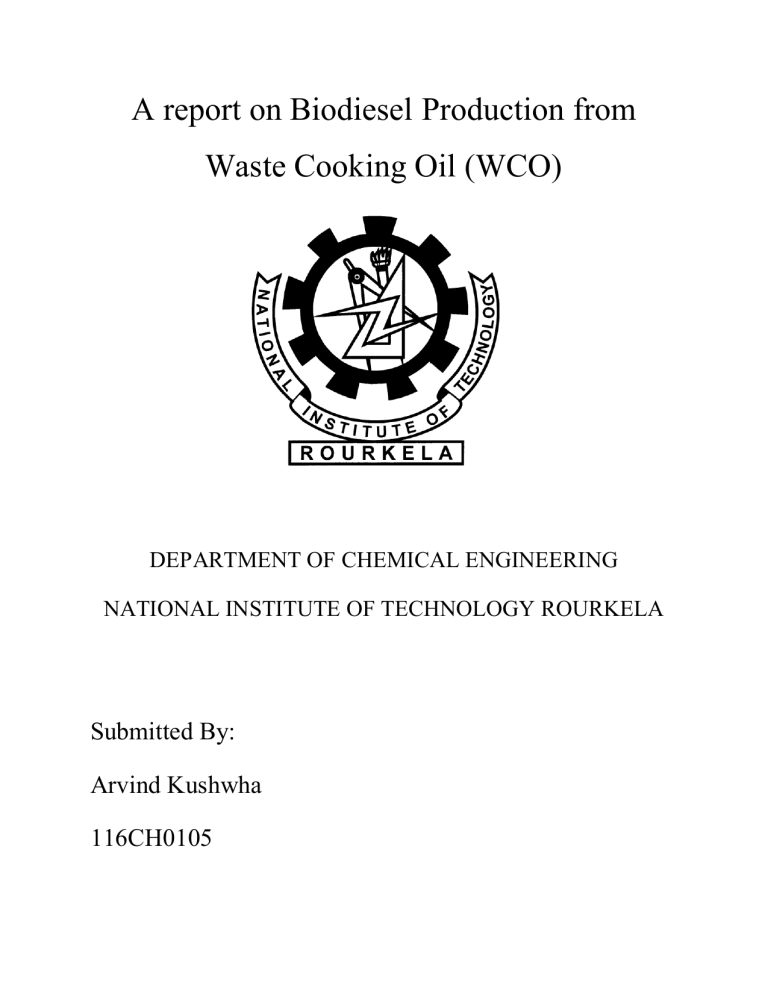
A report on Biodiesel Production from Waste Cooking Oil (WCO) DEPARTMENT OF CHEMICAL ENGINEERING NATIONAL INSTITUTE OF TECHNOLOGY ROURKELA Submitted By: Arvind Kushwha 116CH0105 Abstract Waste cooking oil is not environmentally friendly to dispose, so the viable way in which this problem can be dealt is by converting them into biodiesel. Biodiesel, defined as the monoalkyl esters of vegetable oils or animal fats is an attractive alternative fuel. It is a low emission diesel substitute made from renewable resources and waste lipid. The most common way to produce biodiesel is through alkali-catalyzed transesterification process in which the triglyceride component of oil reacts with alcohol in presence of catalyst. The unique properties of biodiesel such as reduction in green house gas emissions, non-sulphur emissions, non particulate matter pollutants, low toxicity and biodegradability makes it superior to fossil diesel fuel. The yield of biodiesel depends on different transesterification parameters such as oil to alcohol molar ratio, reaction time and temperature, type of catalysts used. This report summarizes in detail about the optimum transesterification condition for the biodiesel production. Introduction With the depletion of the world’s petroleum reserves and the increasing environmental concerns, there is a great demand for alternative sources of petroleum-based fuel, including diesel and gasoline fuels. Biodiesel, a clean renewable fuel has recently been considered as the best alternative for a diesel fuel substitution because it can be used in any compression ignition engine without the need of modification..1 It can be produced from any material containing fatty acids such as animal fats, edible and non-edible oils. More than 95% of biodiesel production feed-stocks comes from edible oils since they are mainly produced in many regions and the properties of biodiesel produced from these oils are much suitable to be used as diesel fuel substitute.2 However, it may cause some problems such as the competition with the edible oil market, which increases both the cost of edible oils and biodiesel. Moreover, it will promote deforestation as more forests will be destroyed for the cultivation of edible oil bearing plants. In order to prevent the food vs energy conflict, the researchers have narrowed themselves to noedible oils and waste cooking oil which are not suitable for human consumption. The use of animal fats is limited as they contain more of saturated fatty acids and normally exist in solid form at room temperature.3 The different technologies used for biodiesel production include: direct use by blending of raw oils, micro-emulsions, thermal cracking and transesterification.4 Transesterification is the reaction of lipid with an alcohol to form esters and a byproduct, glycerol. It consists of a sequence of three consecutive reversible reactions. The first is the conversion of triglyceride to diglycerides, followed by the conversion of diglycerides into monoglycerides, and finally monoglycerides into glycerol, yielding one ester molecule from each glyceride at each step.5 These reactions proceed well in the presence of some homogeneous catalysts such as potassium hydroxide, sodium hydroxide or sulfuric acid, or heterogeneous catalysts such as metal oxides or carbonates.6 Depending upon the type of feedstock each catalyst has its own advantages and disadvantages. The transesterification process is carried out at an average temperature of 50°C to 60°C, with an average reaction time of 2 hours.7 These parameters and yield percentage vary according to the choice of alcohol and catalysts used. Critical Analysis Energy is the major fundamental requirement for human existence and as of now fossil fuels has been serving the world. The entire dependence of mankind on these sources and their limited availability has shifted the focus on alternative energy sources such as wind, geothermal and biofuel. The major reason biodiesel has gained the popularity is that it can be used directly in the diesel engine without any modification. The wide availability of feed-stocks for its production and its degradability nature also contributes to its importance. However, the major barrier in its commercialization is higher cost. The use of edible oils as raw material not only increases the cost but also gives rise to food vs fuel crisis. A lot of research on non-edible oil and waste cooking oil has shown prominent yield still their production is limited to only developed countries like Canada, USA, Germany etc. Currently biodiesel is used in the form of blend with conventional diesel, its direct use is still not in practice. Methanol is widely used alcohol in the transesterification process while choice of catalyst varies depending on the acid value of feed oil. Higher acid value oil requires the process to go through esterification and use of heterogeneous catalyst is more preferable. While homogeneous catalysts have been found more beneficial for low acid value oils because of their lower reaction temperature and higher conversion rate. However, the major issue with homogeneous catalysts is that the biodiesel produced has to be gone through washing process for the catalysts removal which cannot be recovered. The yield of biodiesel can be increased and made cost effective by optimizing the parameters like reaction temperature, oil to alcohol molar ratio, reaction time, type and concentration of catalysts. As the transesterification process is reversible reaction, higher alcohol to oil ratio shifts the reaction equilibrium to product side. The reactions constituent has to be properly agitated for proper conversion. It has been observed that increasing the reaction temperature above 60°C decreases the yield as methanol starts evaporating. Increasing the reaction time aids in the yield of biodiesel. However, excessive use of catalyst only increases the cost and doesn’t impact positively on the yield. The physical properties of biodiesel shows its density to be 87 g/𝑐𝑚3 at 15°C and kinematic viscosity as 1.9-6 𝑚𝑚2 /s. Too high viscosity is disadvantageous as injectors do not perform properly. Biodiesel has higher lubricity than fossil diesel fuel which implies that the diesel running with biodiesel will be less prone to wear and will last longer. Also, on the basis of ignition quality biodiesel can be said to be better as they have higher cetane number than fossil diesel. Concluding Remarks and Future Perspective Biodiesel is better than diesel fuel in terms of sulfur content, cetane number, aromatic content and biodegradability. It has demonstrated a number of promising characteristics in applications for combustion in compression-ignition engines including a reduction of exhaust emissions. It is much less polluting than petroleum diesel, resulting in much lower emissions of almost every pollutant. Use of waste cooking oil as a source for biodiesel production not only saves the environment from being polluted but also helps in counteracting world’s energy crisis. Promoting the use of biodiesel as potential fuel in diesel compression engine has tremendous future aspects. It promotes the cultivation of energy crops which has ultimate environmental benefits such as carbon capture and wildlife improvement. It also provides stable energy security as the petroleum sources are declining and also their prices are continuously rising. References: (1) Leyung, D. Y.; Wu X. A review on biodiesel production using catalyzed transesterification. Applied Eneregy. 2010, 87, 1083-1095. (2) Kolhe, N. S.; Gupta, A. R.; Rathod, V. K. Production and purification of biodiesel produced from used frying oil using hydrodynamic cavitation. Resource-Efficient Technologies. 2017, 3, 198-203. (3) Sainin, R. D. Conversion of Waste Cooking Oil. International Journal of Petroleum Science and Technology. 2017, 11 (1), 9-21. (4) Abdullah, N. H.; Hasan, S. H.; Yusoff, N. R. Biodiesel production based on Waste Cooking Oil. International Journal of Materials Science and Engineering. 2013, 1 (2), 94-99. (5) Yusuf, N. N.; Kamarudin, S. K.; Yaakub, Z. Overview on the current trends in biodiesel production. Energy Conversion and Management. 2011, 52, 2741-2751. (6) Ahmed, B.; Samaddar, O. U.; Kibria, K. Q. Production of Biodiesel from Used Vegetable Oils. International Journal of Scientific Research in Science and Technology. 2019, 6 (4), 86-92. (7) Mowla, D.; Rastri, N.; Keshavarz, P. Tranesterification of Waste Cooking Oil for Biodiesel Production using modified Clintoptiolite Zeolite as a Heterogeneous Catalyst. International Journal of Chemical and Molecular Engineering. 2016, 10 (9), 1201-1205.



